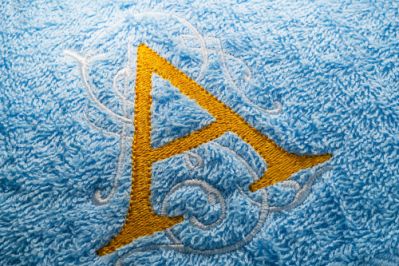 As modern nuptial celebrations evolve, traditions have shifted, changed, or been discarded altogether. Monograms were a staple at weddings in time past, but they don’t show any signs of falling by the wayside. To know how to incorporate your own, it’s essential to understand the principles behind their design and use.
As modern nuptial celebrations evolve, traditions have shifted, changed, or been discarded altogether. Monograms were a staple at weddings in time past, but they don’t show any signs of falling by the wayside. To know how to incorporate your own, it’s essential to understand the principles behind their design and use.
What’s the Big Deal About Monograms?
Our contemporary monograms have far older roots. Southern Living writer Betsy Cribb explains that they date to ancient Greek and Roman times. Rulers designed their own official seals and stamped the coins they issued. During medieval times, artisans used monograms to sign their creations. These letter combinations gained a high-society reputation when upper-class families adopted the practice during Victorian times. Eventually, they gained widespread popularity even as brand trademarks. One example is the distinctive Louis Vuitton logo, with its elegant serif lettering and precise placement of the initials.
Monograms in Wedding Themes and Décor
Monograms certainly have an air of sophistication, which is why it’s no surprise that they became popular at weddings. These emblems typically appear as cake toppers, on signs and other printed goods, and as part of décor. Brides writer Anna Price Olson points out, many more inventive ways exist to incorporate this design into your special day: invitations, napkins, and table runners, just to name a few.
Amid these popular trends, one question comes to mind: Should you use your new monogram before the wedding? Experts are divided on the issue. Traditional etiquette suggests that you wait to use a joint monogram until after the marriage has taken place. Customarily, the only exception to this is for goods on your wedding registry. If you’re not going the traditional route, feel free to add them as ceremony and reception details. At the same time, Vogue’s Madeleine Luckel cautions against overuse. Monograms work best as a few deliberate touches that draw the eye rather than competing with each other for attention.
How To Design Your Unique Emblem
In time past, monograms would feature the couple’s last name as a larger initial in the center while the bride’s first initial appeared to its left and the groom’s on its right. For example, Antonio and Marcia Johnson’s monogram would appear as MJA.
With changing customs, couples create their monograms by combining their initials in specific ways. The Knot reveals some of these techniques. For brides who don’t change their last names, their couples’ emblems usually feature only dual initials separated by a dot, diamond, or other visual elements. If Marcia from our example keeps her original last name of Hightower, their monogram could be styled as H*J. With hyphenated last names, a dash should separate the combined surname’s initials with hers to the left and his to the right: for instance, MH-JA.
Same-gender couples can use similar approaches to their monograms. In these cases, there are no hard-and-fast rules about whose initials should appear first. Anna Price Olson describes a modern take on the practice, using only the couple’s first initials in their emblem. The Knot also discusses more intricate designs with additional details such as hand lettering and graphic illustrations. With a talented artist, you could wind up with a monogram that looks more like a family crest.
Timeless Elegance, Modern Style
Like many wedding customs, monograms have been adapted for usage in modern times. Some adore the classic versions with their traditional sophistication, while others prefer a contemporary approach with clean lines and simple fonts. Either way, they can make statements about a couple’s personalities, outlook, and tastes. Creating an emblem is relatively straightforward, but you’ll need to come to a consensus about its design. As with other decisions made during your married life, this one requires a little collaboration and thought for a successful outcome.
Add Your Comment